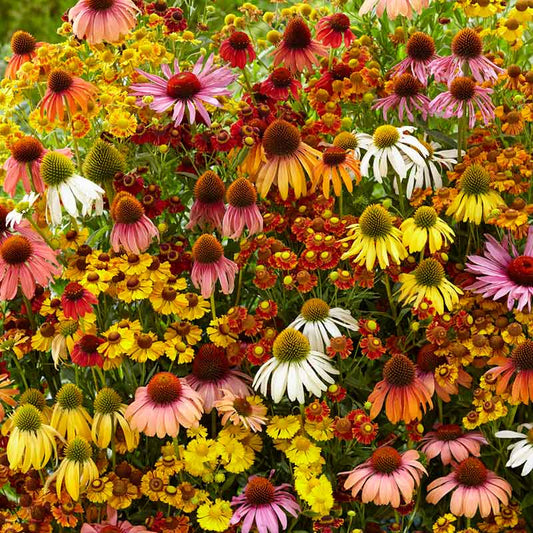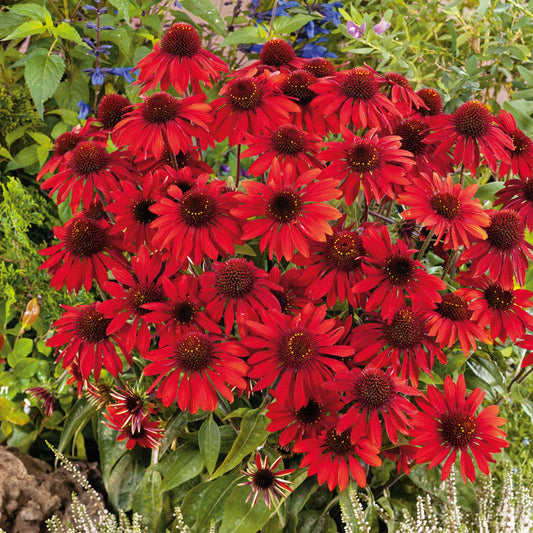-
main-collection-product-grid

Echinacea Roots - Purple
A well-known North American wildflower with medicinal propertiesEchinacea Roots - Purple
A well-known North American wildflower with medicinal propertiesRegular price As Low As $18.99Regular priceUnit price per -
main-collection-product-grid

Echinacea Roots - Mix
This colorful coneflower mix is perfect for raised beds and bordersEchinacea Roots - Mix
This colorful coneflower mix is perfect for raised beds and bordersRegular price As Low As $28.99Regular priceUnit price per -
main-collection-product-grid

Echinacea Helenium Butterfly Attractor Mix
The perfect perennial pollinator attractor for your gardenEchinacea Helenium Butterfly Attractor Mix
The perfect perennial pollinator attractor for your gardenRegular price As Low As $49.99Regular priceUnit price per -
main-collection-product-grid

Echinacea Roots - Green Twister
Large blooms that can measure 4 inches acrossEchinacea Roots - Green Twister
Large blooms that can measure 4 inches acrossRegular price As Low As $18.99Regular priceUnit price per -
main-collection-product-grid

Echinacea Roots - Supreme Cantaloupe
Part of the Supreme® series, offering heavy bloom, strong color, large flowers and full, branched plants with an extra-long bloom seasonEchinacea Roots - Supreme Cantaloupe
Part of the Supreme® series, offering heavy bloom, strong color, large flowers and full, branched plants with an extra-long bloom seasonRegular price As Low As $29.99Regular priceUnit price per -
main-collection-product-grid

Echinacea Roots - Cheyenne Spirit Mix
All-America Selections winner noting the range of colors, sturdiness and low water needsEchinacea Roots - Cheyenne Spirit Mix
All-America Selections winner noting the range of colors, sturdiness and low water needsRegular price As Low As $25.99Regular priceUnit price per -
main-collection-product-grid

Echinacea Roots - Sombrero Salsa Red
Part of the Sombrero® series, featuring compact, tough stems and excellent consistency of flower coloration over a long period of timeEchinacea Roots - Sombrero Salsa Red
Part of the Sombrero® series, featuring compact, tough stems and excellent consistency of flower coloration over a long period of timeRegular price As Low As $29.99Regular priceUnit price per -
main-collection-product-grid

Echinacea Roots - Pink Double Delight
More consistently double with multiple blooms on each stemEchinacea Roots - Pink Double Delight
More consistently double with multiple blooms on each stemRegular price As Low As $29.99Regular priceUnit price per -
main-collection-product-grid

Echinacea Roots - Sunseekers Mineola
Vivid orange color and bred for vigor in a compact, uniform habitEchinacea Roots - Sunseekers Mineola
Vivid orange color and bred for vigor in a compact, uniform habitRegular price As Low As $29.99Regular priceUnit price per -
main-collection-product-grid

Echinacea Roots - Hot Summer
Blooms change color as they mature creating a dazzling displayEchinacea Roots - Hot Summer
Blooms change color as they mature creating a dazzling displayRegular price As Low As $29.99Regular priceUnit price per -
main-collection-product-grid

Echinacea Roots - Sunseekers Salmon
Soft, salmon-pink color and bred for vigor in a compact, uniform habitEchinacea Roots - Sunseekers Salmon
Soft, salmon-pink color and bred for vigor in a compact, uniform habitRegular price As Low As $29.99Regular priceUnit price per -
main-collection-product-grid

Echinacea Roots - Sunseekers Rainbow
Lower growing coneflower with a kaleidoscope of colorEchinacea Roots - Sunseekers Rainbow
Lower growing coneflower with a kaleidoscope of colorRegular price As Low As $29.99Regular priceUnit price per
Planting echinacea roots in your yard
- 12 echinacea bulb varieties
- Excellent for pollinators
- Also known as coneflower
- Prefers full sun exposure
Growing echinacea from bulbs
A card-carrying member of the sunflower family, echinacea is a drought-tolerant perennial that can be found growing throughout eastern and central North America. Also known as purple coneflower, echinacea has become a popular addition to many a home gardener's yard, however, they got their start growing wild in prairies and open wooded areas. Echinacea has tall stems that can reach up to five feet in height, and gorgeous, long-lasting purple and pink flowers with hairy disked centers. The leaves are typically fuzzy and rough-textured, however, sometimes they lack hair. Typically, the leaves will decrease in size the further up the stem they get. They are easy to spot from far away, and once you can identify them, it is likely you will see them all over.
Medicinal properties of echinacea
In addition to being beautiful, the flowers of echinacea are also sometimes used as a medicinal herb. Widely used by the North American indigenous peoples as folk medicine, echinacea's medicinal uses date back to the 18th century. Echinacea tea is still a relatively popular beverage that is purported to help strengthen the immune system and fight off colds. That said, no significant medical evidence supports this. Like many plants, the echinacea plant contains phenols. These protect the plant from infections and may have some beneficial antioxidant properties.
Planting echinacea is easy
Planting and growing echinacea roots is easy. In the spring, once all threat of frost has passed, find a spot in your yard that has full sun. Partial shade will be tolerated, but is not prefered. Echinacea is sensitive to overly moist soil, so ensure that the soil is well-draining. However, poor and rocky soil is tolerable. Once the ideal location has been found, dig a hole that is roughly twice the size of the root clump. Do this for each clump. Plant the echinacea root clump, carefully spreading the roots out. Slowly add soil until it is even with the top of the roots. Afterwards, lightly compress the soil and water deeply.
Maintaining echinacea plants
To extend the flowering season of echinacea, deadhead the spent flowers. Let the plants stand until they have fully died back, and then cut them down once they are fully dormant.
For more information about growing, planting, and caring for echinacea roots, see the Echinacea Bulbs Planting Guide.











